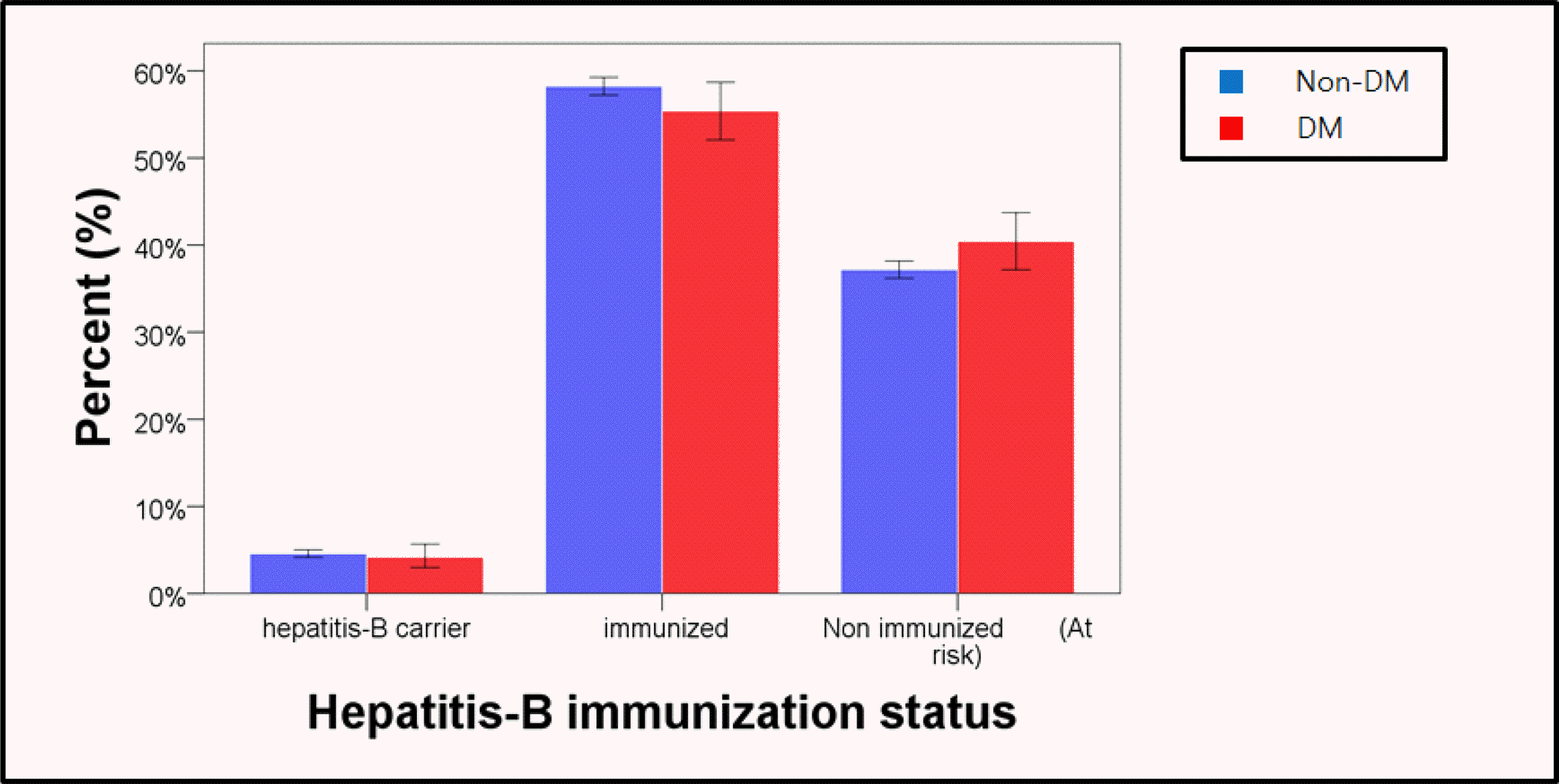Abstract
Objectives
The American Diabetes Association (ADA) recommends hepatitis-B virusVIruS vaccination for unvaccinated adults with diabetes. However, the Korean Diabetes Association (KDA) did not recommend hepatitis-B vaccination for unvaccinated adults with diabetes. This study was performed to assess the differences in hepatitis-B virus antigen and antibody status between Korean patients with diabetes and those without by using national survey data.
Methods
We analyzed hepatitis-B virus antigen and antibody status in 9,771 South Korean people from the general population based on the Korean National Health and Nutrition Examination Survey. Diabetes patients were defined as those with a measured fasting plasma glucose over 126 mg/dL or those who had been previously diagnosed with diabetes by other health care centers.
Results
Subjects with diabetes accounted for 812 (8.3%) among the 9771 study subjects. The prevalence ofhepatitis-B (HBsAg) seropositive subjects was not significantly different (3.9% vs. 4.6%, P = 0.09) between subjects with diabetes and those without. The prevalence of hepatitis-B antibody (HBsAb) positive subjects and unimmunized subjects was not significantly different (55.2% vs. 58.2%, P = 0.09, 40.9% vs. 37.2%, P = 0.09) between the two groups. The prevalence of unimmunized subjects decreased by age (< 20 years 33.3 % vs. 33.0%, 20~29 years 49.1% vs. 41.2%, 30~39 years 41.9% vs. 37.7%, 40~49 years 35.1% vs. 33.5%, 50~59 years 39.0% vs. 38.0%, 60~69 years 41.2% vs. 39.8%, > 70 years 48.5% vs. 42.8%) but was not significantly different between the 2 groups.
Go to : 
REFERENCES
1.Emerging Risk Factors Collaboration. Seshasai SR., Kaptoge S., Thompson A., Di Angelantonio E., Gao P, et al. Diabetes mellitus, fasting glucose, and risk of cause-specific death. N Engl J Med. 2011. 364:829–41.

2.American Diabetes Association. 3. Foundations of Care and Comprehensive Medical Evaluation. Diabetes Care. 2016. 39:S23–35.
3.Treatment Guidelines for Diabetes (5th edition) [Internet]. Korean Diabetes Association. Available from:. http://www.diabetes.or.kr/pro/pub-lishlguide.php?mode=list.
4.Bender TJ., Wise ME., Utah O., Moorman AC., Sharapov U., Drobeniuc J, et al. Outbreak of hepatitis B virus infections associated with assisted monitoring of blood glucose in an assisted living facility-Virginia, 2010. PLoS One. 2012. 7:e50012.

5.Centers for Disease Control and Prevention (CDC). Use of hepatitis B vaccination for adults with diabetes mellitus: recommendations of the Advisory Committee on Immunization Practices (ACIP). MMWR Morb Mortal Wkly Rep. 2011. 60:1709–11.
6.Jeong S., Yim HW., Bae SH., Lee WC. Changes of Hepatitis B Surface Antigen Seroprevalence in Korea, 1998-2005. Korean J Epidemiol. 2008. 30:119–27. Korean.

7.Thompson ND., Perz JF. Eliminating the blood: ongoing outbreaks of hepatitis B virus infection and the need for innovative glucose monitoring technologies. J Diabetes Sci TechnoI. 2009. 3:283–8.

8.Centers for Disease Control and Prevention(CDC). Transmission of hepatitis B VIruS among persons undergoing blood glucose monitoring in long-term--care facilities- Mississippi, North Carolina, and Los Angeles County, California, 2003-2004. MMWR Morb Mortal Wkly Rep. 2005. 54:220–3.
9.Reilly ML., Poissant T., Vonderwahl CW., Gerard K., Murphy TV. Incidence of acute hepatitis B among adults with and without diabetes, 2009-2010. 49th Annual Meeting of the Infectious Disease Society of America and the HIV Medicine Association; Boston, MA, October. 2011.
10.Younossi ZM., Gramlich T., Matteoni CA., Boparai N., McCullough AI. Nonalcoholic fatty liver disease in patients with type 2 diabetes. Clin Gastroenterol Hepatol. 2004. 2:262–5.

11.Mehta SH., Brancati FL., Sulkowski MS., Strathdee SA., Szklo M., Thomas DL. Prevalence of type 2 diabetes mellitus among persons with hepatitis C virus infection in the United States. Ann Intern Med. 2000. 133:592–9.

12.Antonelli A., Ferri C., Fallahi P., Pampana A., Ferrari SM., Goglia F, et al. Hepatitis C virus infection: evidence for an association with type 2 diabetes. Diabetes Care. 2005. 28:2548–50.

13.Hyams KC. Risks of chronicity following acute hepatitis B virus infection: a review. Clin Infect Dis. 1995. 20:992–1000.

14.El-Serag HB., Tran T., Everhart JE. Diabetes increases the risk of chronic liver disease and hepatocellular carcinoma. Gastroenterology. 2004. 126:460–8.

15.Klonoff DC., Perz JF. Assisted monitoring of blood glucose: special safety needs for a new paradigm in testing glucose. J Diabetes Sci TechnoI. 2010. 4:1027–31.

16.Samandari T., Malakmadze N., Balter S., Perz IF., Khristova M., Swetnam L, et al. A large outbreak of hepatitis B virus infections associated with frequent injections at a physician's office. Infect Control Hosp Epidemiol. 2005. 26:745–50.

17.Mast EE., Weinbaum CM., Fiore AE., Alter MJ., Bell BP., Finelli L, et al. A comprehensive immunization strategy to eliminate transmission of hepatitis B virus infection in the United States: recommendations of the Advisory Committee on Immunization Practices (ACIP) partII: immunization of adults. MMWR Recomm Rep. 2006. 55(No.RR-16):1–13.
Go to : 
 | Fig. 1.Distribution of hepatitis-B immunization status among diabetes and non-diabetes subjects. |
Table 1.
Baseline characteristics of study subjects
Table 2.
Age and Obesity adjusted means of liver function
| Variables | Diabetes (n = 812) | Non diabetes (n = 8959) | P-value |
|---|---|---|---|
| Aspartate aminotransferase, AST, SGOT* | 30.71 ± 0.69 | 27.07 ± 0.21 | < 0.001 |
| Alanine aminotransferase, ALT, SGPT* | 31.35 ± 0.75 | 25.83 ± 0.23 | < 0.001 |
| AST** | 30.12 ± 0.69 | 27.13 ± 0.21 | < 0.001 |
| ALT** | 30.17 ± 0.75 | 25.95 ± 0.23 | < 0.001 |
Table 3.
Distribution of hepatitis-B immunization status according to different age groups by diabetes status




 PDF
PDF ePub
ePub Citation
Citation Print
Print


 XML Download
XML Download